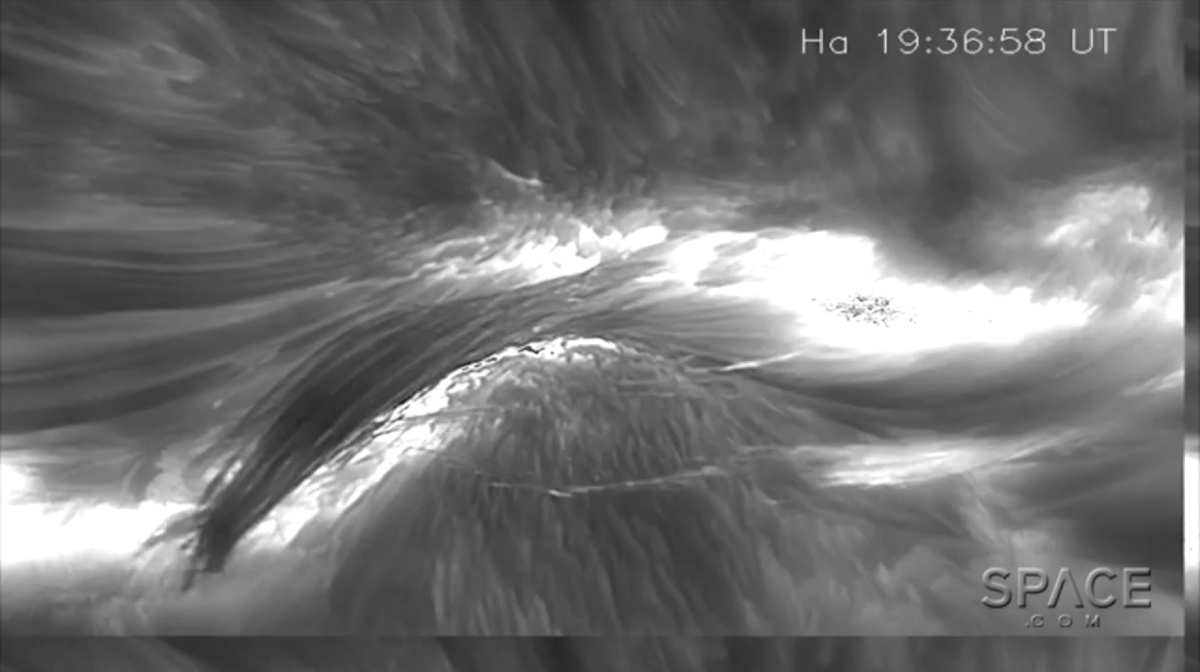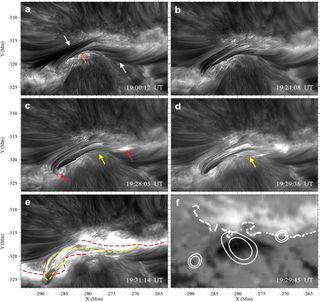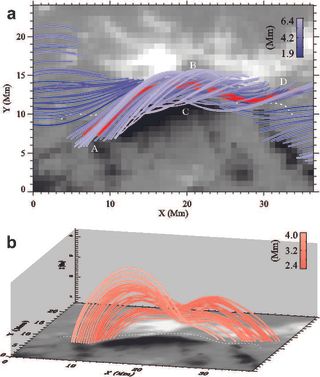Solar Ropes Writhe on the Sun in First Hi-Def Pictures, Video

Twisted ropes of hot plasma and light on the surface of the sun that writhe like snakes can now be seen in high definition.
These solar flux ropes — also known as coronal loops or solar prominences — can be seen in stunning detail thanks to new observations taken by the 1.6m New Solar Telescope at the ground-based Big Bear Solar Observatory in California. You can watch a high-definition video of the ropes on Space.com. The ropes are created by invisible magnetic fields, which can be seen when visible material is pulled along them.
Scientists think these solar flux ropes are linked to explosions on the surface of the sun that spew high-energy particles out into space. These solar eruptions can cause problems for satellites and power grids, and a better understanding of the explosions and the flux ropes could provide an early warning system for Earth. [The Sun's Wrath: Worst Solar Storms in History]

In the new video, the tubelike form of the solar-flux rope can be seen forming close to the sun's surface, with each end dipping down below. Suddenly, the rope brightens, as if fire had been injected into its core. Its strands twist tighter together, and the rope pushes away from the surface, creating a larger, fiery loop.
"These results provide a first opportunity to witness the detailed structure and evolution of flux ropes in the low solar atmosphere," the authors write in the new paper describing the research, which appeared in the April 28 issue of the journal Nature Communications.
These solar-flux loops have been observed exploding off the sun for years. NASA's Solar Dynamics Observatory and a fleet of other orbiting instruments have provided stunning views of the surface of the sun, and the chaotic things that happen there.

In the last three or four years, scientists have made large strides in connecting the formation of solar ropes with explosive belches of material called coronal mass ejections. These solar explosions occur near the surface of the sun and send showers of plasma and high-energy particles out into space (these are known as solar storms). If those particles head in the direction of Earth, they can damage satellites or send surges of electricity through power grids on the ground.
Get the Space.com Newsletter
Breaking space news, the latest updates on rocket launches, skywatching events and more!
If scientists can establish the link between the appearance of these solar-flux ropes and the ejection of solar material, they might be able to establish an early warning system for Earth. With enough lead time, it would be possible to protect many satellites and power grids from damage that these solar storms can cause.
Follow Calla Cofield @callacofield. Follow us @Spacedotcom, Facebook and Google+. Original article on Space.com.
Join our Space Forums to keep talking space on the latest missions, night sky and more! And if you have a news tip, correction or comment, let us know at: community@space.com.

Calla Cofield joined Space.com's crew in October 2014. She enjoys writing about black holes, exploding stars, ripples in space-time, science in comic books, and all the mysteries of the cosmos. Prior to joining Space.com Calla worked as a freelance writer, with her work appearing in APS News, Symmetry magazine, Scientific American, Nature News, Physics World, and others. From 2010 to 2014 she was a producer for The Physics Central Podcast. Previously, Calla worked at the American Museum of Natural History in New York City (hands down the best office building ever) and SLAC National Accelerator Laboratory in California. Calla studied physics at the University of Massachusetts, Amherst and is originally from Sandy, Utah. In 2018, Calla left Space.com to join NASA's Jet Propulsion Laboratory media team where she oversees astronomy, physics, exoplanets and the Cold Atom Lab mission. She has been underground at three of the largest particle accelerators in the world and would really like to know what the heck dark matter is. Contact Calla via: E-Mail – Twitter












